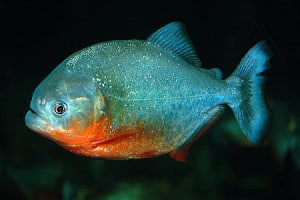
Common name: Red Bellied Piranha
Scientific name: Pygocentrus Nattereri
Average Adult Fish Size: 10 inches / 25 cm
Place of Origin: Currently accepted to occur throughout much of the Amazon basin (Brazil, Ecuador, Peru, Bolivia and questionably Colombia) as well as the Río Essequibo (Guyana and Venezuela), some smaller, coastal drainages in north-east Brazil/the Guianas plus further south in the Río Paraná (Brazil, Paraguay and Argentina) and Río Uruguay (Brazil, Uruguay and Argentina).
Type locality is ‘Cuiabá and Mato Grosso, Brazil’.
Typical Tank setup: Some aquarists maintain this species in bare-bottomed arrangements for ease of maintenance but standard aquarium gravel or sand are both suitable substrates. Other décor is basically down to personal taste but plants may be eaten, especially if the fish decide to spawn. Lighting is relatively unimportant and can be dim to strong as preferred.
Red Bellied Piranha typically produce a lot of waste so the use of one or more over-sized external filter is essential. If possible buy units with inbuilt heaters or at least fit a sturdy heater-guard as adults have been known to damage submerged equipment. Sump systems also work well and the heater can be housed within.
Recommended Minimum Aquarium Capacity: 250 gallon / 1000 litre
Compatibility: Best kept in a species only tank although adults tend to leave much smaller fishes alone if well-fed. In very large aquariums similarly-sized species may not be killed outright but their fins are likely to be viewed as food.
Temperature: 68 – 82 Deg F / 20 – 28 Deg C
Water chemistry: pH 6.0 – 7.5
Feeding: Contrary to popular belief, Red Bellied Piranha are not exclusive carnivores and are more accurately described as opportunistic generalists.
The natural diet consists not only of live fishes but also aquatic invertebrates, insects, nuts, seeds and fruits. Each jaw contains a single row of sharp, pointed, triangular teeth which are used like blades to puncture and tear but equally chop and crush.
They also attack sick or dying fishes, feed on the fins of larger species, and scavenge carcasses, but assaults on live animals entering the water are very rare and mostly relate to accidental biting or cases in which they’ve become trapped in small pools during dry periods, i.e., when food is scarce and the fish present in high densities.
In the aquarium juveniles can be offered chironomid larvae (bloodworm), small earthworms, chopped prawn and suchlike while adults will accept strips of fish flesh, whole prawns/shrimp, mussels, live river shrimp, larger earthworms, etc.
This species should not be fed mammalian or avian meat such as beef heart or chicken since some of the lipids contained in these cannot be properly metabolised by the fish and may cause excess fat deposits and even organ degeneration.
Similarly there is no benefit in the use of ‘feeder’ fish such as livebearers or small goldfish which carry with them the risk of parasite or disease introduction and at any rate tend not have a high nutritional value unless properly conditioned beforehand.
Sexing: You can’t tell the gender of a red bellied piranha unless you watch for differences that might give you a clue that they are opposite sex. Namely, males tend to darken up sooner, first in most cases to make a depression in gravel (blowing), they also can be seen tail slapping (though either sex does the same thing, but male usually does it first). Female are a bit more robust in the body, but not always a key to say for sure.
Breeding: Sexual maturity is reached at around a year of age and 10-15 cm in length. Unless you can find a sexed pair start with 6+ and allow a pair or two to form naturally. In some cases spawning has been initiated by large, cool water changes whereas in others it occurred without intervention.
As males come into sexual condition they become isolated from the rest of the group and excavate a patch of substrate using the mouth and caudal-fin. Aquatic plants may also be cropped if present and the resultant ‘nest’ is defended against other males.
Receptive females demonstrate interest by mouthing the substrate around the nest, and when ready to spawn both male and female darken in body colour. Eggs and spawn are deposited in several batches and guarded by the male, sometimes assisted by the female. In large aquaria multiple pairs may spawn simultaneously.
The eggs hatch in 2-3 days with fry free-swimming by the fifth. At this point it’s best to siphon them into smaller sponge-filtered set-ups. Several meals of Artemia nauplii/microworm and water changes of ~10% tank volume are required daily.
The fry become increasingly cannibalistic as they grow so should be moved to progressively larger aquaria in batches of similar size. Think carefully before taking on such a project, however, as you could end up with 1000+ young piranhas with very little sell-on value.
Additional Information: Although they have a reputation of being man eaters and the deadliest and most vicious fish known to man, the Red Bellied Piranha doesn’t quite live up to this reputation. This reputation has come from several films, notably the 5th James Bond film – “You Only Live Twice” and more recently horror movies such as “Piranha 3D” and “Piranha 3DD”.
If you have ever observed the Red Bellied Piranha you will notice it is a fairly peaceful animal and doesn’t do a great deal in the aquarium once it is settled and when it is not feeding time. This has it’s benefits though as observing the fish can be very peaceful and relaxing as you are not constantly chasing it around the tank!


Related Posts
Croaking Gourami – Trichopsis vittatus
Paradise Fish – Macropodus opercularis
Schubert’s Barb – Barbus Semifasciolatus